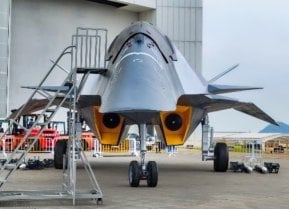A-10 Warthog: Nuclear Bomber
Did you know: that the U.S. Air Force (USAF) considered modifying the A-10 Warthog to deliver tactical nuclear weapons? It’s true.
Did you know: that the U.S. Air Force (USAF) considered modifying the A-10 Warthog to deliver tactical nuclear weapons? It’s true.
In 1975, the USAF commissioned a feasibility study to gauge the costs of outfitting the vaunted A-10 with a nuclear weapon. The costs: $86 million in 2024 dollars, proved prohibitive. The USAF passed on the modification and the idea faded into obscurity as a piece of dusty aviation trivia.
A Different Animal
Outfitting the A-10 to carry tactical nuclear weapons would have required significant redesigns. For one thing, “nuclear ordnance is heavy, and it was not clear if the A-10 airframe could even carry a warhead,” Brett M. Eastwood wrote. Would the A-10’s engine have been able to provide the thrust necessary to carry such heavy ordnance?
As designed, the A-10 is arguably the greatest close-air combat support airframe ever built. Had the designers started tinkering with the A-10, making adjustments for the sake of accommodating nuclear weapons, compromises likely would have been made that may have reduced the airframe’s abilities to provide such exceptional close air support.
The very nature of the airframe could have been different. Today, with the A-10 as-is so well established in aviation lore, such an adjustment, or compromise, is difficult to comprehend.
“But in 1975, the nuclear triad needed an update,” Eastwood wrote. “Yes, the Air Force had B-52 bombers, but war planners wondered if they could get a jet that could fly faster and lower and have some ability to escape evasion from ground fire. The A-10 would give the Air Force a different option and diversity of nuclear strike capability.”
Flying High Now
The A-10 had another problem, performance at high altitudes. The A-10 is renowned for its ability to fly low and slow, loiter over battle spaces, and execute heavy banks and steep dives. However, the A-10 performs poorly at high altitudes. Naturally. She wasn’t designed to operate at high altitudes. But when dropping a nuclear weapon, you’re not going to want to be at low altitudes; you’re going to get caught up in the blast radius.
That’s a bad deal for the nuclear-weapon-delivering pilot. Instead, you’re going to want to operate at high altitudes, to deliver your ordnance safely, and then get out of Dodge. To operate effectively at higher altitudes, the A-10 would have needed some modifications – which again, likely would have diminished the airframe’s ability to perform close air support effectively.
In the end, the A-10 was found lacking with respect to delivering nuclear ordnance. Unlike other nuclear-capable bombers, the A-10 lacked standard safety features like hardened storage areas and fail-safe mechanisms to prevent accidental nuclear detonations. The USAF didn’t want to shell out another $86 million and passed on the proposal. The A-10 was left alone to do what it has done so well ever since providing close air support.
About the Author: Harrison Kass
Harrison Kass is a defense and national security writer with over 1,000 total pieces on issues involving global affairs. An attorney, pilot, guitarist, and minor pro hockey player, Harrison joined the US Air Force as a Pilot Trainee but was medically discharged. Harrison holds a BA from Lake Forest College, a JD from the University of Oregon, and an MA from New York University. Harrison listens to Dokken.
Image Credit: Creative Commons and/or Shutterstock.


